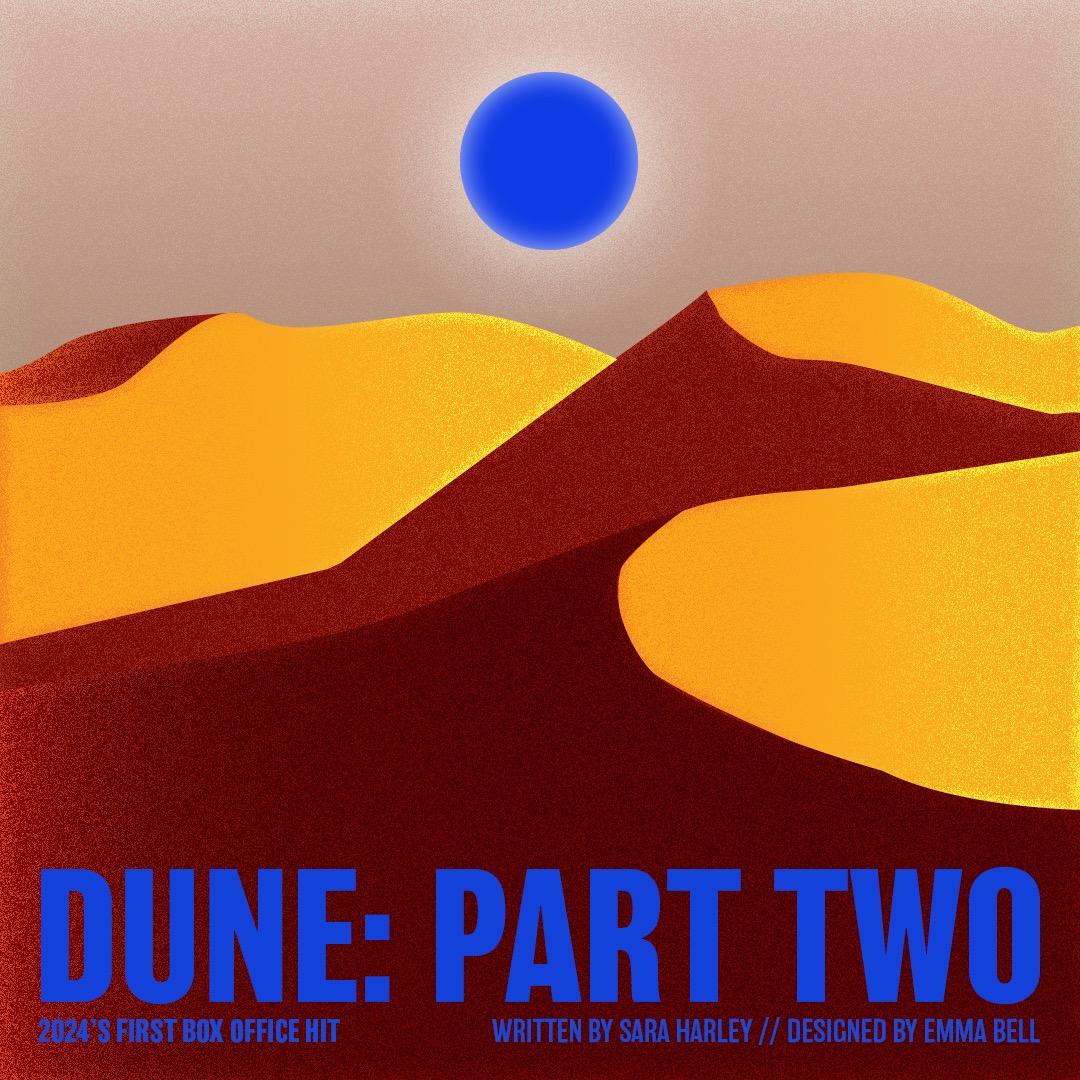
SPOILER ALERT: The following review contains spoilers to “Dune: Part 2.” Proceed with caution.
I am usually not a fan of science fiction. But, when I saw the Letterboxd reviews for Dune’s second installment, I had to make an exception. Directed by Denis Villeneuve, “Dune: Part 2” is a sensational next adaptation to Frank Herbert’s infamous book series. Timothée Chalamet stars as Paul Atreides who seeks revenge against House Harkonnen, an evil bloodline that rules over planet Arrakis and murdered Atreides’ family. To defeat them, he joins forces with Chani, played by Zendaya, and a native rebel group, Freman.
The books were practically made for visual adaptation — otherworldly, original, action-packed. However, they’re dense. The first book is over 650 pages including a 50-page glossary entitled “Terminology of the Imperium.” It’s so long that Herbert divided it into three sections — each is dedicated to a different society in his Galactic Empire. In this way, the film adaptation makes the author’s work available to a wider audience who may not have the time or wherewithal to endure all six books.
In full transparency, my family and I were never able to watch the first movie. As we walked into the theater, I tried to recall what I could from when I tried to read the first book years ago. Surprisingly, I found that the second movie can stand alone. Clocking in at nearly three hours long, the film provides lots of context for unfamiliar audiences.
To enjoy this film, throw Western morality out the window. From kissing cousins to a sacred pool made of water drained from dead bodies (that disastrously gets spilled everywhere), Villeneuve proves that nothing is off limits in modern cinema despite the rise of cancel culture.
Villeneuve’s uses of cinematography, lighting, color, costumes and set design all work together seamlessly to create a single spell-binding narrative. The film is utterly stunning; oranges and desert tones symbolize the poor conditions of the “common man” while blue symbolizes expensive commodities such as spice and water. Spice, or melange, is a special drug that enhances brain function and is essential for space travel. A symbol of wealth, it turns users’ eyes blue and is the driving force of planet Arrakis’ economy. The absence of color to capture the wickedness of the film’s villain family House Harkonnen was absolutely genius. Villeneuve uses infrared (black-and-white) lighting during an Oscar-worthy gladiator scene between villain Feyd-Rautha, played by Austin Butler and an unarmed Atreides soldier. Butler’s skin is so white it glows. The suspenseful scene will surely put him in the running for next year’s awards season.
Despite its success, the film has been heavily criticized for cultural appropriation of Muslim and Arabic culture. Many of the female characters wear niqabs (similar to a hijab that also covers the face except for the eyes), the script uses many words derived from Arabic and the desert setting all help create a Middle Eastern backdrop for a primarily Western audience. While Middle Eastern, North African, and Muslim influences should by no means not make the movie controversial, the exoticism of these components and the lack of proper representation should be challenged.
Especially when one considers the harsh reality of the violence in the Middle East, the barrier between the appreciation and cringe-worthy misuse of Muslim “aesthetics” has become particularly thin. During the press tour for the movie, Anya Taylor Joy walked the red carpet in a sheer hijab-inspired veil. What is supposed to be a symbol of modesty hardly covered the deep V-neck Joy wore underneath. The film was also released in the wider context of the wider Israel-Hamas war, which when compared to the film’s desert setting, highlights the film’s ignorance when it comes to its influences.
“The vaguely Arab desert backdrop becomes a place of intrigue and mystique (fit, even, to become the backdrop of a glamorous premiere) rather than the underdeveloped sites of war that the Middle East is usually portrayed as,” according to an article in the New Arab. Unsurprisingly, while the movie heavily relies on Middle Eastern culture, no Middle Eastern actors were cast. While it appears that Villeneuve and Herbert did not borrow Arab and Middle Eastern culture with malicious intent, these choices deserved more time and thought.
Despite the film’s erasure of its cultural inspirations,, Dune’s second installment was received as an enormous triumph in film editing and entertainment. Generating $178.5 million during its global box-office debut in early March, the film series has the potential to reach the same fame as the “Harry Potter,” “Star Wars” and “Avengers” movies by the time the next installment is released. It’s unique in that cinephiles, those who love to examine the meaning and art behind the camera, and casual fans can all enjoy it.
Like any good film, “Dune: Part 2” forces audiences to question the values of modern society. Villeneuve continues to push the envelope of filmmaking by resurrecting stories that make audiences feel. He takes his place among only a handful of directors who have made sequels as successful, if not more so, than the original (e.g., “Before Sunset,” “The Dark Knight Rises,” “Pitch Perfect 2”). Nevertheless, it will be no easy task for the director to create a third installment as enthralling as the second. But, if anyone is up for the challenge, it’s him.